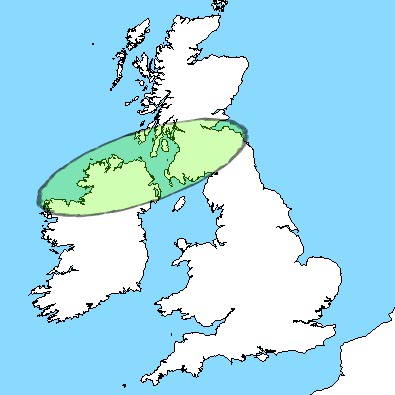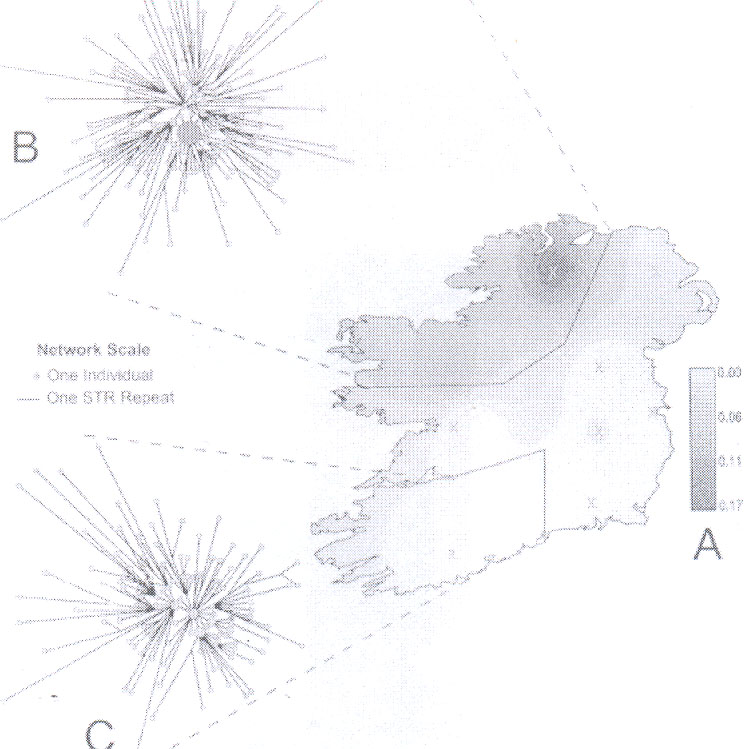Brit-Am

Brit-Am



Date: Fri, 21 Sep 2007 03:28:16 -0400 (EDT)
From: Lochlan@aol.com
Subject: Re: [DNA-R1B1C7] Ui Neill Dynasty - Why some O'Neills aren't M222+
In a message dated 9/20/2007 5:08:35 P.M. Central Standard Time, pconroy63@gmail.com
writes: I just noticed this very interesting PDF the other day - many regular
readers may have seen it already:
http://www.jogg.info/22/ONeill.pdf It basically finds evidence of a
non-paternal event in the O'Neill line. As one who has studied the O'Neills for
years I have to say this didn't surprise me much. Seamus O Ceallaigh
(Gleanings from Ulster History, 1952) pointed out several problems in the
O'Neill pedigree and history, which is based largely on a 17th century
document, the Lebor Eoghanach. If anyone would like to read the article you
can find it here:
http://members.aol.com/Mlochlan/ulster.htm To be fair, O Ceallaigh also
found severe problems with the history and pedigree of the McLaughlins, the
closest kin to the O'Neills. If these problems exist in the line of the major
kings of the north of ireland one can only imagine the problems in lesser
lineages. In a nutshell, the problem with the O'Neills is this: The O'Neill
surname first arose with descendants of Domhnall 'of Armagh', the High King of
Ireland, who died 980 A.D. For two or three generations his descendants, all
called Ua Neill in the annals, held the kingship of Aileach. Then after the
death of Aedh Athlaman and Flaithbertach an trostain Ua Neill (1033 and 1036)
the O'Neills were completely eclipsed by their closest kin, the McLaughlins.
The McLaughlins held the kingship of Aileach (ie, the north of Ireland) for the
next 150 years, completely excluding the O'Neills from the succession. During
this long, dark night of the O'Neills not a single O'Neill was named king of
anything in the annals; their pedigree is completely untraceable in the annals;
and obviously in error when compared to the much better authenticated pedigree
of the McLaughlins. Then suddenly, from nowhere, pops up Aedh Ua Neill 'the
lazy youth', who was suddenly named King of Aileach despite the now interloper
status of the O'Neills in the succession. Aedh's kingship didn't last long - he
was slain in 1177 by two Mclaughlins who then regained the kingship. But from
then on the O'Neills are mentioned again in the annals and by 1241 A.D. had
wrested the kingship from the McLaughlin rivals once and for all. The point is
the O'Neill pedigree and history are unverifiable for a period of 150 years or
about five generations in the annals. And if there was some kind of NPE event
it most likely occurred during this time period because after the time of Aedh
'the lazy youth' Ua Neill the O'Neill pedigree is well traceable in the Irish
annals. In later centuries there were rumors aplenty about O'Neill bastards.
Plantation of Ulster Rev. George Hill p. 22 "Conn O'Neill, who accepted an
English earldom in the year 1542, and died in 1559. This Ulster prince fell
prey to certain English servitors, including the Bagenalls, who were able to
intermeddle with his family affairs, and who eventually induced him to adopt
the son of a Dundalk blacksmith, named Kelly, to the exclusion of his only
legitimate son, Shane O'Neill. One of our best irish archaeological authorities
- O'Donovan - believed that Con O'Neill's heir was really the son of a
blacksmith, and this his [the heir's] son, who is known in history as Hugh
O'Neill, second earl of Tyrone, was not, therefore, an O'Neill at all. Could a
fairly late event such as this have resulted in the largest group of O'Neills
in Ulster who are not R1b1c7? 17th century English writers often had derogatory
things to say about the O'Neills (Fynes Moryson's [1566-1630] The Irish
Sections - Unpublished Itinerary, ): "And so the Oneales boldly rushed into
the possessions the English had left voyde in Ulster, and not only the true
Oneales, but every bastard warranted by his mother to call himselfe Oneale, if
he were more bold and bloody then the rest, did from that time beare themselves
for lords of Ulster." "They have likewise a ridiculous cutstome, that maryed
women give Fathers to their Children when they are at the point of death.
Insomuch as they have a pleasant tale, that a yonger son hearing his mother
give base Fathers to some of his bretheren, besought her with teares to give
him a good father. but commonly they give them fathers of the Oneales, O
Donnells or such great men, or at least those that are most famous for
licentious boldness. and these bastard Children ever after follow these
fathers, and thinking themselves to descend of them, will be called swordmen,
and scorning husbandry, and manual Arts live only of rapine and spoyle." The
problem with the large group of O'Neills in Ulster who are not R1b1c7 though is
they seem remarkably compact, tightly clustered in DNA showing a probable
single common ancestor. This doesn't seem to fit well with the English claims
of irish women on their deathbeds giving their sons famous names or with
various unrelated males proclaiming themselves to be O'Neills. The following
quote from the O'Neill article would seem to place the NPE event closer to the
dark night of the O'Neills than to any more recent bastard of later centuries:
". It is noted that, using only their 80 O'Neills and haplotypes within one
mutational step or less of ONMH, McEvoy and Bradley estimated the TMRCA of
about 1,100 years (about 900 CE), very close to the time frame of the grandson
of Niall Glundubh, Domhnall ??of Armagh ??, said to be the first to use the
surname O ??Neill. " If we could ever find an O'Neill chief to test some new
light might be shed on this issue. John